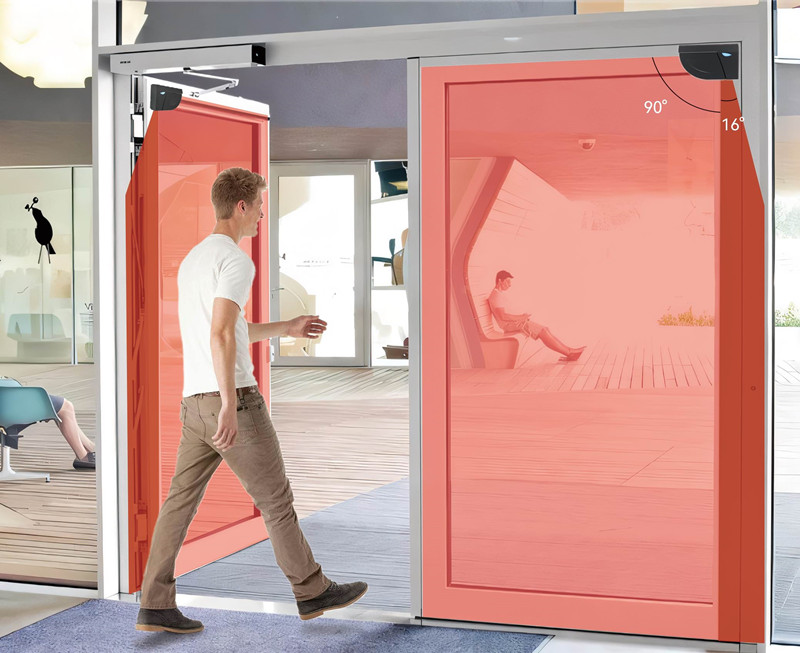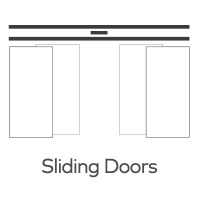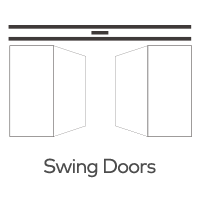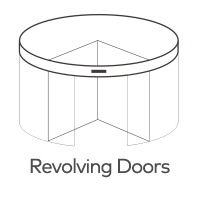Comment les capteurs laser sont-ils conformes aux codes de construction pour l'évasion d'urgence dans les espaces commerciaux?
In commercial spaces, laser sensors integrated into automatic doors play a critical role in ensuring safety, accessibility, and compliance with building codes. Emergency egress, or the safe and efficient evacuation of people during emergencies, is one of the key areas where laser sensors contribute significantly. To comply with building codes, laser sensors must meet stringent safety, performance, and reliability standards that align with emergency egress requirements. This article explores how laser sensors help automatic doors comply with these codes while maintaining a balance between functionality and safety. Key Building Code Requirements for Emergency Egress
Key Building Code Requirements for Emergency Egress
Building codes are designed to ensure the safety of occupants in commercial spaces during emergencies such as fires, power outages, or natural disasters. Here are some of the critical requirements that laser sensors must address:
- Unobstructed Exit Pathways: Emergency exits must remain free of obstacles at all times to facilitate quick evacuation.
- Fail-Safe Operation: Automatic doors must either remain operational or revert to a fail-safe state, allowing manual operation during power outages or system malfunctions.
- Rapid Door Activation: Doors must respond quickly to ensure minimal delay in evacuation.
- Compliance with Accessibility Standards: Doors must accommodate individuals with disabilities, as mandated by laws like the ADA (Americans with Disabilities Act).
- Fire Safety Integration: Doors must work in coordination with fire alarms and suppression systems to maintain a safe egress pathway.
How Laser Sensors Contribute to Compliance
Laser sensors enhance the functionality and safety of automatic doors, making them suitable for emergency egress in commercial spaces. Here’s how they meet specific building code requirements:
1. Ensuring Unobstructed Exit Pathways
Laser sensors are equipped with advanced motion and presence detection technologies that continuously monitor the area near automatic doors.
- Functionality: Sensors detect whether the area around the door is clear of obstacles and ensure that doors open fully during an evacuation.
- Building Code Alignment: This complies with requirements for maintaining an unobstructed egress route, as outlined in standards like NFPA 101: Life Safety Code and IBC (International Building Code).
2. Fail-Safe Operation During Power Outages
In emergencies, power supply interruptions are common, but laser sensors and door systems must remain functional to allow safe evacuation.
- Functionality: Laser sensors are integrated with backup power systems, such as batteries or emergency generators, to ensure continued operation.
- Building Code Alignment: Complies with requirements for fail-safe operation, ensuring doors either remain open or allow manual override.
3. Rapid and Reliable Door Activation
During emergencies, doors must activate quickly and reliably to prevent crowding and delays in evacuation.
- Functionality: Laser sensors provide high-speed response times, detecting motion or presence in milliseconds and signaling the door to open instantly.
- Building Code Alignment: Meets the requirements for rapid door activation as specified in ANSI/BHMA A156.10 and EN 16005.
4. Accessibility for Individuals with Disabilities
Laser sensors ensure that automatic doors are fully compliant with accessibility standards, making evacuation safe and efficient for everyone, including individuals with mobility challenges.
- Functionality: Sensors detect slow-moving or stationary individuals, preventing the doors from closing prematurely.
- Building Code Alignment: Ensures compliance with ADA standards, which require doors to accommodate individuals using wheelchairs, walkers, or other assistive devices.
5. Integration with Fire Safety Systems
Automatic doors equipped with laser sensors must work seamlessly with fire alarms and suppression systems.
- Functionality: Sensors can override normal operational settings and switch to emergency modes when connected to fire alarm systems, ensuring doors unlock and remain open for evacuation.
- Building Code Alignment: Complies with fire safety codes such as NFPA 72: National Fire Alarm and Signaling Code and IBC Section 716.
Advanced Features of Laser Sensors for Emergency Egress
Laser sensors used in commercial spaces often include advanced features to enhance their functionality during emergencies:
- Customizable Detection Zones: Sensors can be programmed to detect movement and presence in specific areas, ensuring precise activation of doors during evacuations.
- Multi-Directional Sensing: Modern laser sensors can detect motion from multiple directions, making them suitable for high-traffic commercial spaces.
- Environmental Adaptability: Sensors can operate effectively in varying light, temperature, and humidity conditions, ensuring reliability during emergencies.
- Self-Diagnostics: Many laser sensors come with self-diagnostic capabilities to detect faults and alert maintenance teams before they lead to critical failures.
Standards Governing Laser Sensors in Emergency Egress
Laser sensors in automatic doors must comply with various international standards to ensure safety and reliability in emergency scenarios:
- EN 16005: Focuses on the safety requirements for automatic pedestrian doors, including emergency egress.
- ANSI/BHMA A156.10: Regulates the performance of power-operated pedestrian doors in North America.
- NFPA 101: Provides guidelines for life safety, including unobstructed and safe egress pathways.
- IEC 60825: Ensures the safe operation of laser products, preventing hazards associated with laser emissions.
- ISO 13849: Specifies requirements for the safety-related parts of control systems, ensuring fault tolerance and reliability.
Challenges in Complying with Building Codes
Despite their advantages, integrating laser sensors into automatic doors for emergency egress presents challenges:
- Cost: High-quality sensors with advanced features can increase installation and maintenance costs.
- Integration Complexity: Ensuring seamless communication between sensors, door systems, and building management systems requires careful planning.
- Environmental Factors: Outdoor commercial spaces may require weather-resistant sensors, which can be more expensive and complex to implement.
- Regular Testing: Frequent testing is required to ensure sensors meet performance standards, adding to operational costs.
Benefits of Compliance
Ensuring that laser sensors comply with building codes for emergency egress offers several benefits:
- Enhanced Safety: Protects occupants during emergencies by facilitating quick and efficient evacuation.
- Regulatory Compliance: Avoids legal liabilities and penalties by adhering to local and international codes.
- Increased Reliability: Ensures doors operate seamlessly in high-pressure scenarios, boosting trust among building occupants.
- Market Appeal: Compliant systems are more attractive to property owners and facility managers.
Conclusion
Laser sensors are integral to the safe and efficient operation of automatic doors in commercial spaces, particularly during emergencies. By complying with building codes such as NFPA 101, ANSI/BHMA A156.10, and EN 16005, laser sensors help ensure unobstructed egress, accessibility, and integration with fire safety systems.
While compliance can be challenging, the benefits in terms of safety, reliability, and regulatory adherence far outweigh the costs. As technology advances, laser sensors will continue to play a pivotal role in making commercial spaces safer and more secure for everyone.







